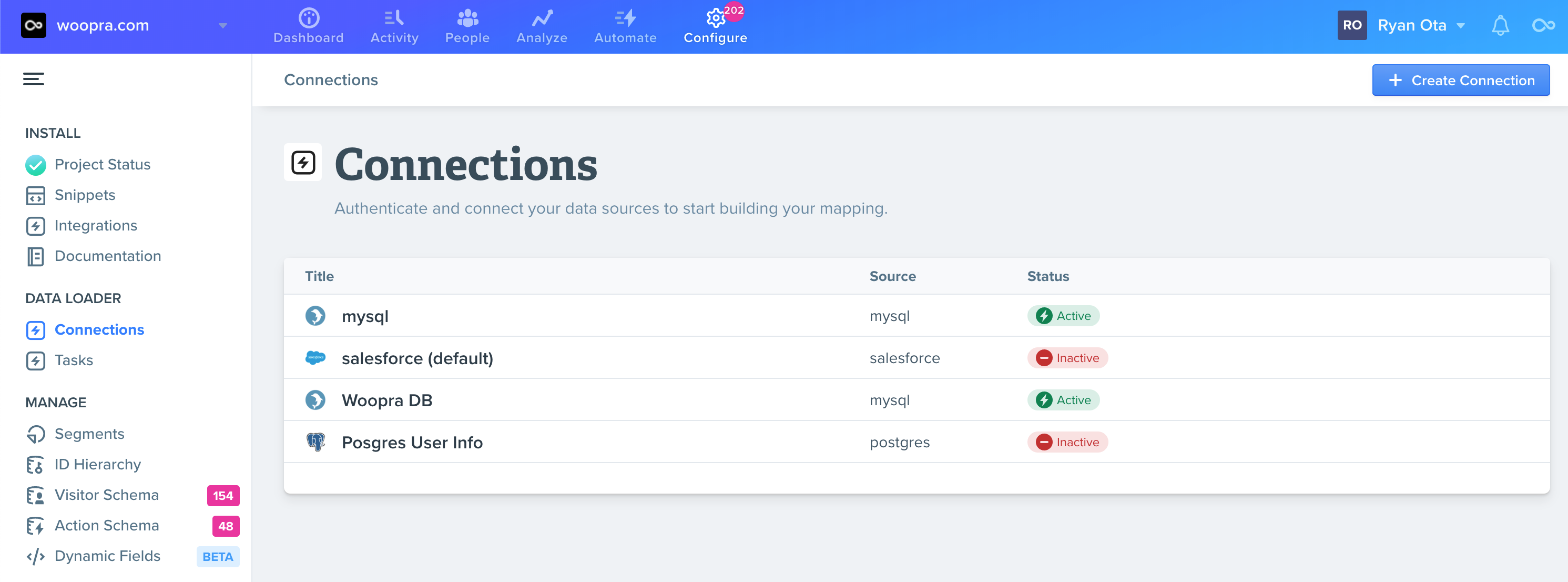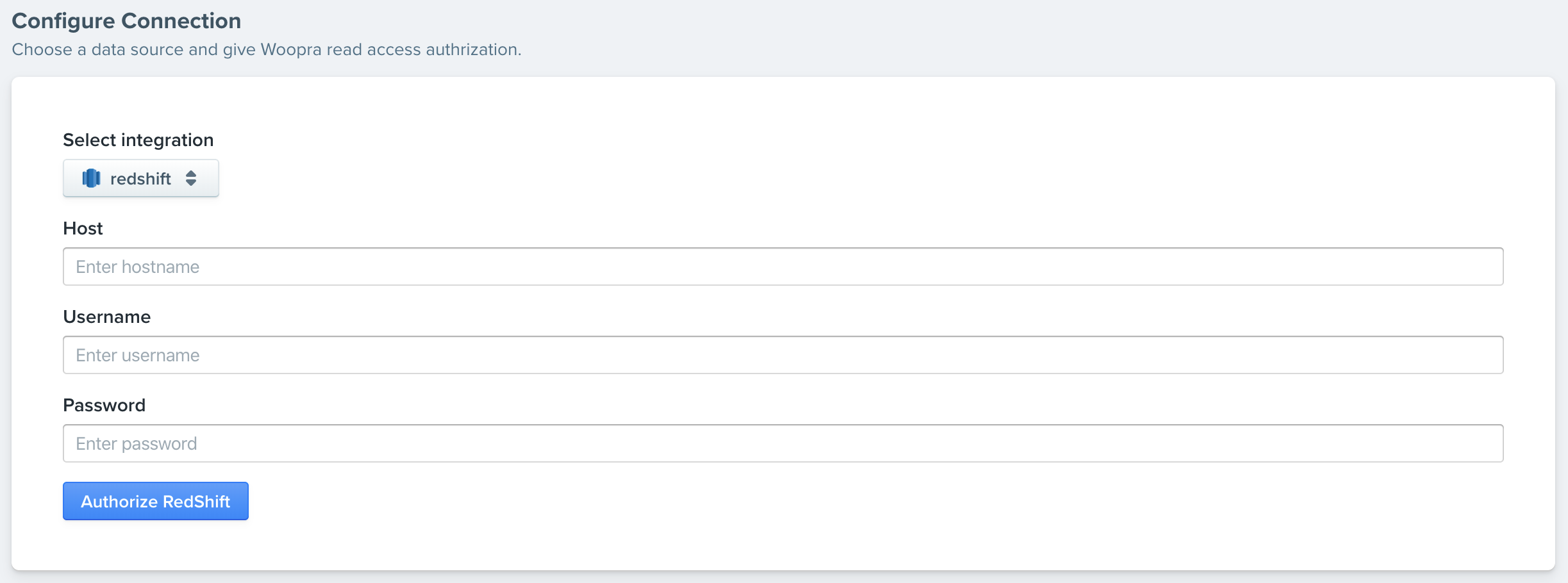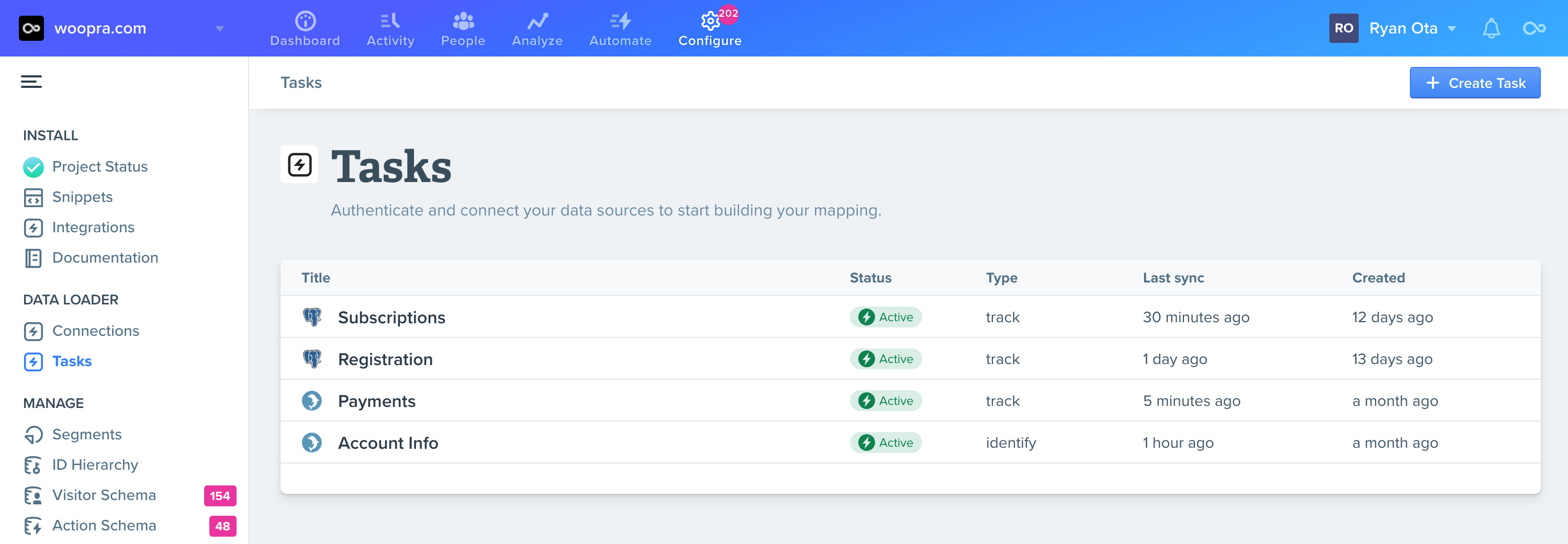Data Loader Overview
Data Loader allows you to import current and historical data from external data sources for instant availability to run analytics on your data.
Need help?Our data loader is designed to use without the need for a developer. It's easy to set up and get going.
However, if you're looking for extra help, our Pro and Enterprise plans include a customized onboarding to help you reach your goals. For more info contact us at [email protected].
Features and Benefits
Data Integrity
Maintain lossless data from your database. Relying on frontend or clientside tracking can often lose data due to various factors such as blockers or incorrect coding. A direct connection to your database maintains a 1 to 1 ratio of your event data.
Historical Data
Event-based client and serverside tracking records data in real-time. However, there's no way to access historical data unless it was recorded in Woopra. When connecting to your database, we can pull any historical data and retroactively import past data and user information for immediate consumption and analysis.
No Developer Required
Often with traditional event tracking, you need a developer to code custom events on your site. With the Data Loader, all you need is the database credentials to start importing data. Setup is easy, and you can simply select what data you want to bring in -- no coding required.
What you'll need
- Database Credentials: Required to access your database.
- Unique Identifiers: Required so we can tie activity and user data to the correct user's profile.
- Event Data: What events are the user doing, and optionally what metadata is associated with these events? (e.g., view page x, make a payment, use feature X).
- Date/Timestamps: Required — we must know when the user did that particular event.
Connect Your Database
Whitelist IPs
If your data source is behind a private subnet, you might need to whitelist our server IPs so we can access the data. Here is the list of IP addresses you'll need to whitelist. You will need to whitelist all of the following IPs. This applies to any database or self-hosted database that may be behind a firewall such as SQL databases (e.g. BigQuery, Redshift, Snowflake, etc.).
Whitelist IPs++ |
|---|
91.134.5.49 91.134.5.47 91.134.9.197 91.134.9.196 91.134.10.28 91.134.10.25 91.134.10.247 91.134.44.151 91.134.44.143 91.134.44.134 |

Under the Connections section is where you'll add all your databases.
- Navigate to the Configure tab at the top, then click Connections on the left side in the Data Loader section.
- Click Create Connection in the upper right.
- Select your integration from the dropdown and enter your credentials.
- Save the connection.

Schedule Your Tasks
Configure what data to bring in from your data source and when to check for updated/new data.

Check and recheck your tasks before making them active!When you bring in new data and events, this can cause profiles to merge. While it's possible to delete events, we cannot un-merge profiles. Make sure you have set up the tasks correctly. If you are unsure, contact [email protected] with any questions.
- Navigate to the Configure tab at the top, then click Tasks on the left side in the Data Loader section.
- Click Create Task in the upper right.
- Name and configure the task (see below).
Unique Identifiers and Profile Merging
Source Configurations
Table
Select the table you want to use for importing your data. Simply select the source and navigate to the table you want to select.
Optional Table Joins
It's also possible to import data from multiple tables by configuring the relations or joins for the tables you'll be using. Joining tables allows you to pull in data from multiple tables and tells Woopra how the tables relate to each other.
- Select the data source you'll be using.
- Select the table you want to use.
- If you'll are using multiple tables, you can define how the tables relate by selecting a common field that's shared by both tables. This is called a primary key - foreign key relationship. For example, if you wanted to use an accounts table and a payment table, both of these tables may share an account ID or perhaps a User ID. See our example below:

Here you can see we are joining the accounts table and the paypal table. We are selecting the common filed, which is the id from the accounts table and the account_id from the paypal table.
Data Types
Import your data as User Properties or Events.
Identify
User Properties are things like company names, emails, first and last names, locations, or any other identifying information.
Track
Event data is anything the user does that contains a timestamp. These can be things like payments, signups, subscription updates, or really any event a user can do in your application.
Track events can also update User Properties.For example say you have an 'Update Profile' event where a user can update their contact info. This could be an event, but can also update the User Properties at the same time.
Select Identify to import User Properties and select Track to import Events data.
Sync Interval
Select the interval for which to check for changes. You can set this as low as 1 minute.
Let's look at the following example. Say you set the task for 10 min intervals. Next, you run a task, and the import takes 1 hour. The interval waits 10 min after the initial task is complete to check for new entries. If there is new data during the next check, we'll import the new data, and once that's done, it will wait 10 min before checking again. The Sync Interval is the delay between running the task.
Tasks run queries on your database.Each time we check for new data according to your selected Sync Interval settings, depending on your database, this could count toward your querying counts and limits. There are no querying limits in Woopra, but be sure to check with your database admins to understand your database limits or querying costs.
Conditions
If you have only certain data you want to bring in from these tables, you can use conditions to filter out the results. For example, say you were importing payment information, but you only wanted to import payments from the United States. If you have country data with the payments, you could select the 'country' column from your table and only import payments from the USA.

Mappings
Configure how to map your user properties and events. After defining what tables and data you want to import, you now need to tell Woopra what to do with that data.
Depending on if you selected to import the data as Identify (user data) or Track (event data), the mapping configuration will change accordingly.
Identify: Select & Map User ID and User Properties
Unique IDs
This is the primary identifier to sync the data to the correct profiles. Typically this will either be a user ID or an email.

Custom IDsPlease contact [email protected] if you are trying to add/use a custom ID.
Properties
Map the columns/fields to sync with your User Properties.
For example, say you have a table in your database that has the person's name, address, country, organization, etc. You can sync these fields to User fields in Woopra profiles.

Here we're mapping the org_name from our database to the org_name User Property in user's profiles.
Cursor
You can think of the Cursor as a bookmark for your data that’s placed when a task completes. Once the task starts again after the set Sync Interval, it will use the Cursor as a starting point to retrieve new data.
Typically the Cursor will be a unique incrementally generated ID, a timestamp or modified date, or any unique and sequential column. Randomly generated IDs will not work.
Track: Map User Events
Select & Map User ID
This is the main identifier to sync the data to the correct profiles. Typically this will either be a user ID or an email.
##Event Name
Choose a name for the event you are importing. For example, make_payment, update_subscription, new_registration, update_profile, etc.
Event Properties
Each event can have its own set of properties. For example, if you have a payment event, this may have properties such as amount, plan type, start date, upgrade, etc.
To map these fields, you'll select the column from your tables, and map those to event properties in Woopra.

Here we created the 'signup' event with the properties: plan_id, org_name, and plan_type.
Timestamp
Select the column that contains the timestamp of the event. Each event must have a timestamp associated with it.
Cursor
You can think of the Cursor as a bookmark for your data that’s placed when a task completes. Once the task starts again after the set Sync Interval, it will use the Cursor as a starting point to retrieve new data.
Typically the Cursor will be a unique incrementally generated ID, a timestamp or modified date, or any unique and sequential column. Randomly generated IDs will not work.
Data Loader Cursor Reset and Task Behavior
Reach Out to SupportPlease be advised that Data Loader imports count toward the event quota, so correctly configuring the Tasks is essential to minimize re-imports and misconfigured data.
Below are some general Task behaviors when deleting, resetting, or altering existing Tasks. If you're unsure how to achieve the desired outcome with the Tasks, please reach out to [email protected], and we will assist you. Each use case may be different, so our team of experts can help determine the best steps to take to reach your goals.
Reset Cursor
When you reset the cursor, this will remove any previously imported event data. Any new profiles that were created or user properties that were updated will remain. However, any imported event data (events with timestamps) from the Task will be deleted from user profiles.
Pausing the Task
This will simply pause the import. When you resume the Task, it will continue where it left off according to the cursor position. Any changes to the Task, while paused, will take effect when resumed and will only apply the changes to newly imported data going forward from where the cursor left off. If you want to make the change for all previously imported data, we recommend resetting the cursor to reimport all the previous data with the updated changes.
Deleting a Connection
When you delete a connection, this will remove the existing Tasks and remove all the imported event data from that connection. We do not advise deleting a connection unless you want to remove all previously imported event data from the associated Tasks.
Updated 2 months ago
